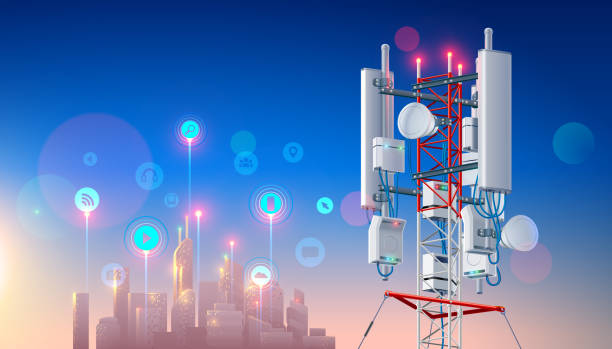The telecommunications sector may be at the forefront of innovation and growth, but it’s facing looming challenges in network load and infrastructure optimization. In addition to the rapid growth and shift of technologies, the aftermath of the COVID-19 pandemic still looms large in many industries and led to unprecedented disruptions.
Technology trends like artificial intelligence, cloud-based solutions, and open technologies are intended to directly address these challenges, while also improving the overall efficiency for telecommunications companies.
A strategic approach is necessary to stay agile in a highly competitive and rapidly evolving industry and market. The telecommunications industries can weather the changes and obstacles by preparing for the future tech and trends that will have the greatest impact.
5G Deployment
5G is the newest generation of wireless communication and a huge upgrade for telecommunication networks and devices. The next in line after 4G, 5G provides much higher speeds than previous cellular broadband network standards with lower latency, which is valuable for cloud gaming, VR content streaming, and more.
The spread of smart and IoT devices increases the communication channels, such as vehicle-to-everything, machine-to-machine, and device-to-device communication. 5G networks also offer massive machine-type communications (mMTC) that enable the creation of high-density IoT networks, including Industrial Internet of Things (IIoT) and smart homes.
Some of the other applications for 5G include:
- High-speed mobile networks
- Remote access
- Logistics and shipping
- Fleet management
- Patient medical tracking and monitoring
- Security and surveillance
- Smart factories
- Smart homes
- Robotic surgery
- Satellite internet
- RFID
- Live event streaming
- Agricultural drones
- AR/VR shopping
- Assistance robots
- Collaborative gaming
- Autonomous vehicles
Because of this, 5G is arguably the most important upcoming technology trend for the telecommunications industry. It essentially supercharges the wireless network, supporting rapid data download speed and an always on, always connected mobile experience.
Internet of Things (IoT)
IoT emerged as a highly beneficial technology for consumers and industries alike, leading to increasing adoption and more and more use cases. The pandemic moved the adoption of IoT forward tremendously, as it offered a solution for businesses that couldn’t shift workforces to remote work. Instead, they implemented smart technologies and IoT devices to handle the work that employees no longer could.
As adoption increases, smart devices are becoming more available, more agile, and more intelligent, leading to more possible applications and innovative uses with greater investment. Businesses can increase profits, improve management, monitor expenses, and more.
The interconnectivity between devices, sensors, infrastructure, and computing elements offers more opportunity for management and communications, such as decentralized operations and predictive maintenance. In this respect, IoT automates production processes and allows for greater implementation in the telecommunications industry.
Edge Computing
When the pandemic forced shelter-in-place orders and quarantines, businesses need to shift to remote work and take their business online to stay connected to customers. While many businesses believed a remote or hybrid workforce or internet-based services weren’t possible, the pressures of the pandemic forced innovation and creativity.
One of the biggest challenges of this is cybersecurity, however. Many employees were working from home – and still are – creating potential vulnerabilities in business data and a home network. Security is vital to remote and online services, no matter the industry, but more important in telecommunications.
When businesses shifted their workforces to remote and hybrid models, they typically used the cloud for data transfer and storage. Technologies like 5G improve security and enhance remote capabilities, shoring up the vulnerabilities in home networks and business data.
The whole of the telecommunications industry requires data security, requiring AI to move from the central data core to the edge on the device level, such as NXP iMX8 single board computers.
By keeping the data close to the device and the end user, networks have high connectivity with ultra-low latency. Data can be transferred in real-time, allowing businesses to make rapid decisions and take action on mission-critical problems. In addition, the data that needs to be transferred to the cloud is reduced, decreasing the congestion and delays on the network from transferring massive amounts of data.
Data processing can also be optimized with connected devices as edge computing, which is at the forefront of the telecommunications industry. As businesses and IoT devices amass larger and larger data volumes, edge computing is a necessary technology to ensure that businesses can use it effectively.
Artificial Intelligence (AI) and Machine Learning
AI and machine learning are essential to the future of IoT and data. When combined, these two technologies are among the most disruptive telecommunications technology trends. Businesses are already leveraging the power of AI and machine learning with applications like predictive maintenance and robotics, allowing them to create more efficient processes with improved network reliability and better customer experience.
Both AI and machine learning help businesses make use of their data and glean real-world insights from it. Without this rapid data processing and analysis, the high volume of data that businesses collect is virtually useless.
One of the best examples of AI technology in telecommunications – as well as other businesses and industries – is virtual assistants and chatbots. These applications reduce the burden on business’s processes and workforce by taking on simple customer questions, concerns, and inquiries, troubleshooting, and more.
Customers have more self-service options, improving their experience, and the business saves the human customer service representatives for more complex customer concerns. Sophisticated chatbots and virtual assistants provide more personalized customer service – and address the customer’s needs faster – all with the insights from data.
For example, telecommunications can use this technology to not only help customers, but to predict trends and monitor their services for outages, glitches, and other problems that can adversely impact the customer experience.
AI-Powered Conversational Platforms
Expanding on the previous trend, AI-powered conversational platforms are in a class of their own and offer a myriad of unique and creative uses. As AI grows in coming years, more and more businesses are expected to adopt AI-powered conversational platforms for customer service.
In the telecommunications sector, this is a significant advantage. Customer service can take a lot of resources for telecommunications, but with conversational AI, telecommunications businesses can provide better and more timely customer service. The telecommunications industry may also use predictive maintenance and network optimization to identify problems and provide better services for businesses and consumers.
DevOps
DevOps is hardly a new technology, but more innovative uses are growing and finding their place in new industries. Businesses can deploy new and advanced DevOps, with network stability, to allow processes to stay reliable and efficient.
DevOps also offers real-time orchestration, minimum time-to-market for new services, effective control over the network, and no manual configuration. This offers highly scalable and efficient solutions to move the industry forward.
Improved Content
Consumers and businesses alike use smart devices, such as smartphones, tablets, and computers, all of which need an internet connection. Any user requires a reliable internet connection to consume content, whether it’s a cat video on social media or an important product demo.
High-resolution content can improve the quality of the media, including images, music, videos, and podcasts, creating more compelling and engaging experiences. The demand for virtual reality (VR) and augmented reality (AR) is also being viewed for more than entertainment, and this technology is opening incredible possibilities for businesses to use it for success.
All of these new media and entertainment options require high-speed transmission with reduced latency, which falls on the telecommunications network. Without these requirements, a streaming or VR experience quickly falls flat, making it more frustrating than transcendent.
There are several options for high-resolution content, including a dedicated internet service, which connects to the internet using an exclusive, private connection. Businesses need great bandwidth for mission-critical processes and content, and using a private internet option ensures a secure connection, reliable speed, and consistent upload and download times, regardless of the traffic and congestion on the rest of the network.
Dynamic Systems
Cyber attacks are increasing, and the spotty security of IoT devices, new central processing unit (CPU) hardware vulnerabilities, and the increasing dependence on computing infrastructure add to the challenges. Systems can be monitored to stay ahead of evolving cyber threats, but this can be at odds with the need for availability and reliability.
Innovative businesses are addressing this in industrial networks by allowing the systems to stay dynamic in the midst of vulnerabilities, breaches, and attacks. Some of these solutions include tools that discover and correct weaknesses in websites and network security and quantum keys for data transmission and making existing infrastructure quantum-safe.
Looking to the Future of the Telecommunications Industry
The innovative technology trends in this article only touch upon the potential benefits and use cases. Telecommunications is up against big challenges, including the demand for high- and low latency, rapid communication, and technology implementation.
Leveraging emerging technologies and finding innovative ways to leverage existing technology offers a competitive advantage. With AI, IoT, network optimization, edge computing, and 5G, telecommunications can address the most significant challenges to prepare for the future and stay agile in the face of rapidly shifting environments.
—
Author Bio: Jason Khoo
 Jason is the Head of SEM at SolidRun which is a global leading developer of embedded systems and network solutions, focused on a wide range of energy-efficient, powerful and flexible products which help OEMs around the world simplify application development while overcoming deployment challenges
Jason is the Head of SEM at SolidRun which is a global leading developer of embedded systems and network solutions, focused on a wide range of energy-efficient, powerful and flexible products which help OEMs around the world simplify application development while overcoming deployment challenges






